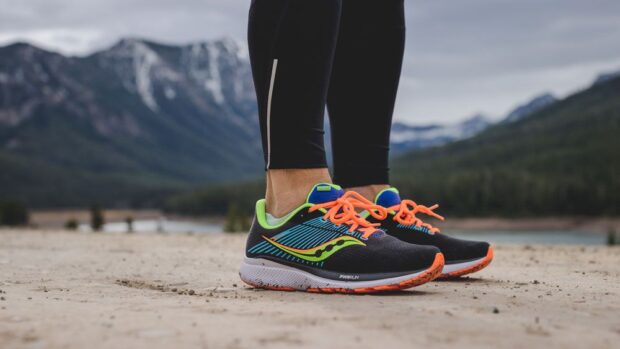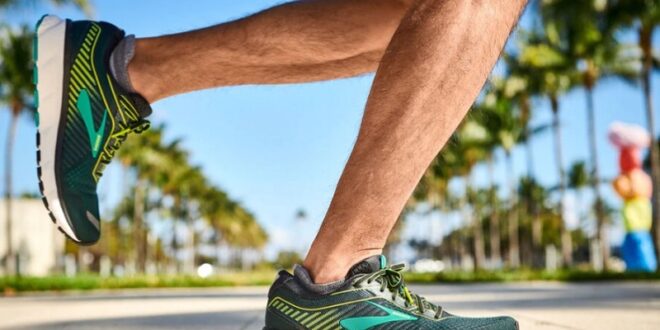Running is a popular form of exercise that appeals to millions worldwide due to its accessibility and numerous health benefits. However, running is also associated with a high risk of injury, particularly when improper footwear is used.
Stability running shoes are designed to mitigate this risk for specific types of runners. This blog post explores how stability running shoes can benefit runners, particularly those with specific biomechanical needs.
Stability Running Shoes In a Nutshell

So stability running shoes are basically the foot police, designed to prevent that wild inward roll of your foot—because heaven forbid your feet just do what they want! These shoes are all about keeping you safe from the horrors of plantar fasciitis, shin splints, and those dreaded knee problems. They’ve got this tough “post” in the midsole acting like a bouncer, trying to straighten out every step you take.
Not everyone needs these control-freak shoes, though. They’re best for those with low arches or flat feet—yeah, those feet that can’t seem to hold their liquor and keep rolling in too much. But hey, if you’re part of that crowd, the extra support might just make your runs less painful and a bit more bearable, aligning everything from your ankles to your hips. Because, you know, it’s all about running without feeling like you’re falling apart.
Benefits of Stability Running Shoes
The capacity of stability running shoes to reduce the risk of injury is one of its main advantages. These shoes are able to better evenly disperse the impact of each step over the foot by aligning the foot and reducing overpronation. As a result, there is less stress concentrated on any one area of the foot, reducing the risk of overuse and misalignment-related problems.
By maximising the foot’s transition from heel strike to toe-off, stability running shoes can also increase running efficiency. This may result in gains in speed, endurance, and form when running. Furthermore, using the appropriate stability shoe might assist runners retain better form by lessening foot and leg strain.
Choosing the Right Stability Running Shoes

Choosing the right pair of stability running shoes involves more than just understanding your arch type. Factors such as the runner’s weight, preferred distance, and running environment (trail vs. road) also play critical roles.
Moreover, the fit of the shoe—ensuring it is neither too tight nor too loose—is crucial for maximizing the benefits while minimizing potential risks. Additionally, when selecting stability running shoes men, it’s essential to consider models specifically designed to support male biomechanics, which can differ in terms of arch placement and foot shape.
Getting a professional fitting at a specialty store is recommended for runners, as it allows them to test the shoes on a treadmill. This enables real-time modifications based on how the running shoes feel. Additionally, a runner can choose the best shoe for their unique demands by taking into account how various brands and models may differ in their stability qualities and overall fit.
Long-Term Use and Care
Like other athletic shoes, stability running shoes have an expiration date. In general, depending on the runner’s size, running style, and the surfaces they run on, they should be changed every 300–500 miles. Noticable wear on the sole, decreased shock absorption, and general discomfort that wasn’t there before are indications that it’s time to replace your shoes.
It’s critical to take good care of stability running shoes in order to prolong their lifespan. This include routine cleaning, letting them dry out fully after being wet, and keeping them out of extremely hot or cold environments. Furthermore, if you only use shoes for running, you can avoid early wear and tear from activities that aren’t intended for them.
Impact on Long-Distance Runners

It’s critical for long-distance runners to keep their comfort level up over miles. Long-term support from stability running shoes helps lessen the weariness that comes with covering large distances. Long runs can be made more comfortable and energy-efficient by keeping an efficient stride, which is made possible by the midsole support. This is especially crucial while preparing for a marathon or other long running sessions where endurance is essential.
Furthermore, stability running shoes may improve performance by minimising the energy expended in overpronation correction. Better performance may result from the alignment’s ability to apply force during the toe-off phase more effectively. By wearing these shoes on a regular basis both during training and competition, long-distance runners may reach their maximum potential without sacrificing comfort or foot health.
Adapting to Different Running Conditions
Although many versions of stability running shoes are adaptable enough to run on diverse surfaces, including mild trails, their primary purpose is road running. They offer the required stability regardless of the terrain thanks to their sturdy construction and structural support, which make them appropriate for a range of running situations. They are a good option for runners who frequently move between various running situations because of their versatility.
It is crucial for runners to choose the appropriate model based on the particular running circumstances they anticipate. Running on trails, for example, may require stability shoes with more aggressive outsoles for improved traction, but runners who adhere to urban settings may value cushioning and responsiveness. Knowing how different models differ from one another might help you choose the right shoes for different situations.
Technological Advances in Stability Running Shoes

Over time, stability running shoe design and technology have improved dramatically, giving runners more comfort and support. Cutting-edge materials and engineering are used in modern stability shoes. Examples include 3D printed bottoms for individualised support, adaptive midsole technologies that adjust to the intensity of a runner’s stride, and enhanced cushioning systems that more efficiently absorb impact. These developments enhance the functionality of the shoes while also making running more customised by catering to unique requirements and preferences in ways that were not previously achievable.
Conclusion
Many runners, especially those who overpronate or have flat feet, find that stability running shoes are an essential tool. Running enthusiasts can enhance their running experience and lower their chance of injury by choosing their footwear with greater knowledge if they are aware of the unique advantages and factors to take into account. Running has many advantages, both psychologically and physically, but there are also disadvantages that can be minimised with the correct shoes.
 Jewel Beat
Jewel Beat

